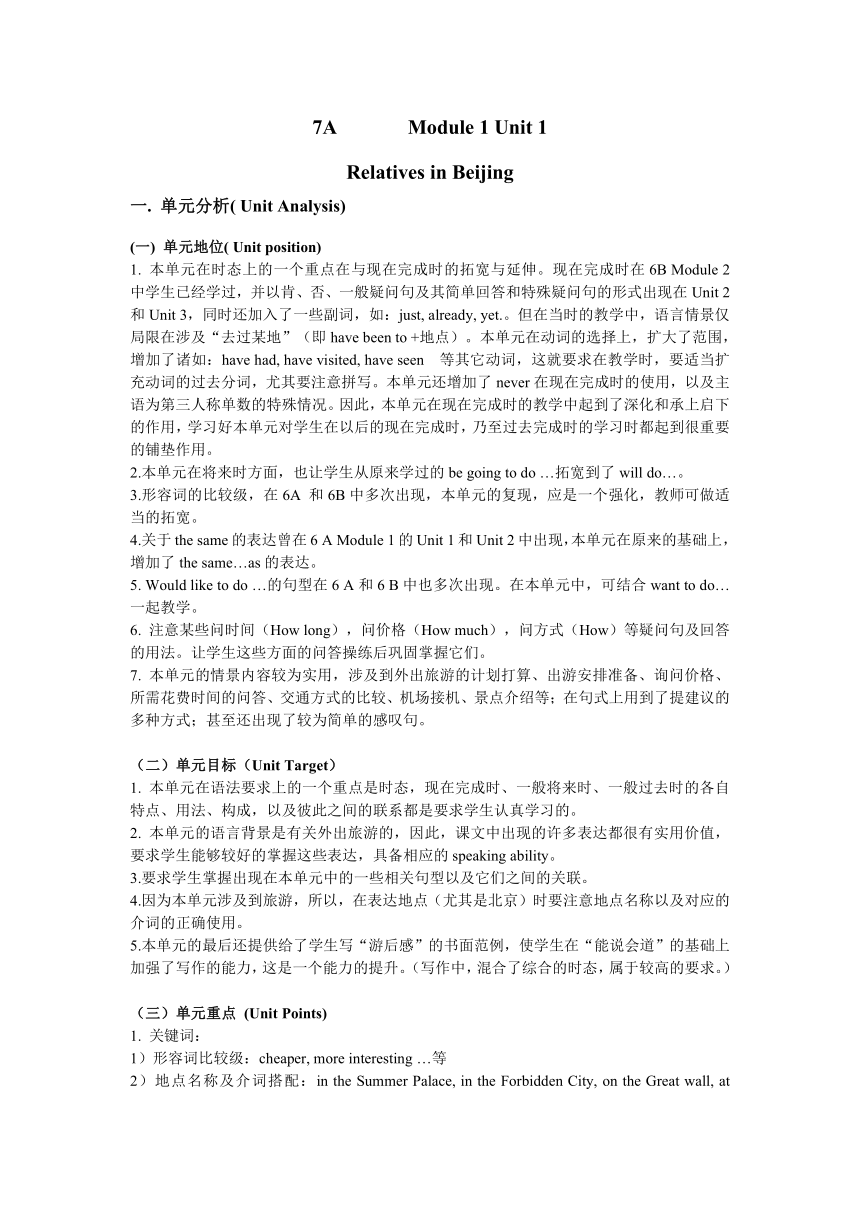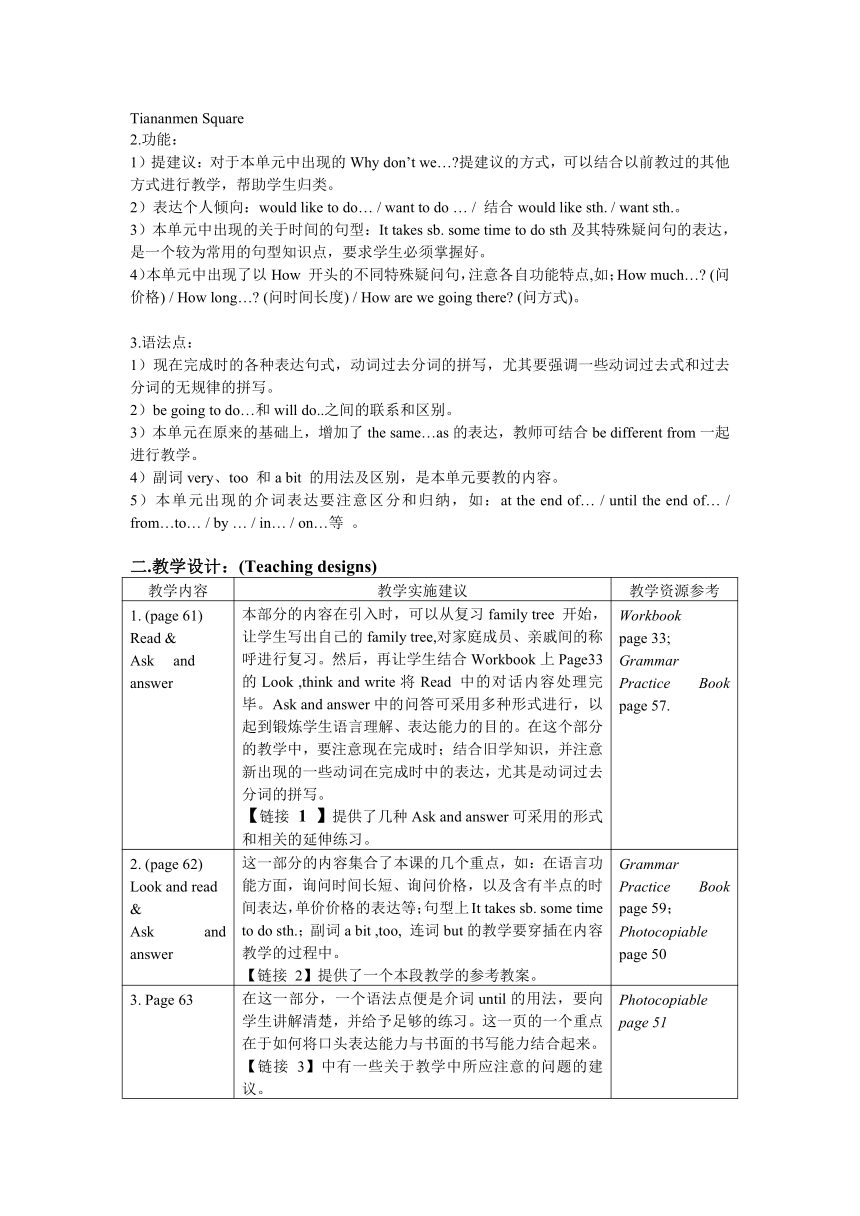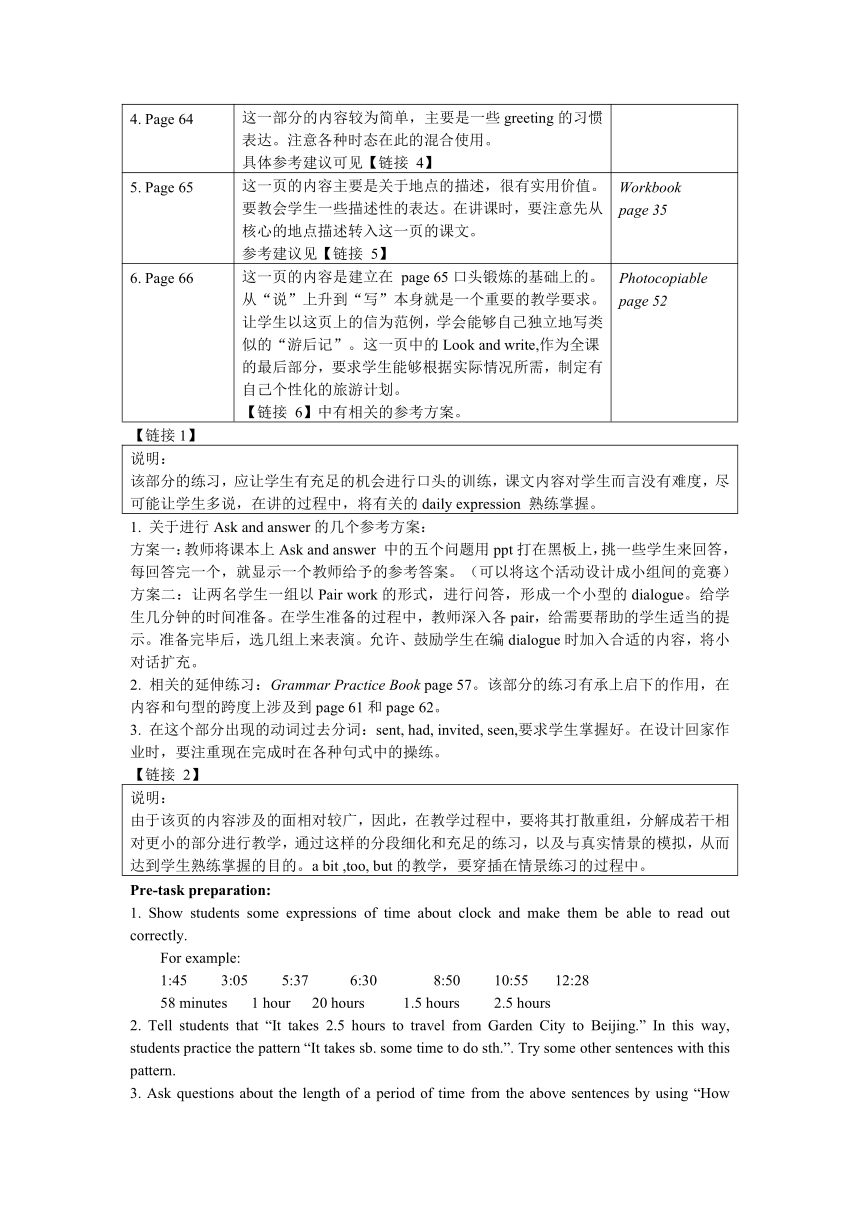Module 1 Relationships Unit 1 Relationships in beijing 教案
文档属性
| 名称 | Module 1 Relationships Unit 1 Relationships in beijing 教案 |

|
|
| 格式 | zip | ||
| 文件大小 | 25.1KB | ||
| 资源类型 | 教案 | ||
| 版本资源 | 牛津上海版(试用本) | ||
| 科目 | 英语 | ||
| 更新时间 | 2015-12-24 13:35:15 | ||
图片预览



文档简介
7A Module 1 Unit 1
Relatives in Beijing
一. 单元分析( Unit Analysis)
(一) 单元地位( Unit position)
1. 本单元在时态上的一个重点在与现在完成时的拓宽与延伸。现在完成时在6B Module 2中学生已经学过,并以肯、否、一般疑问句及其简单回答和特殊疑问句的形式出现在Unit 2和Unit 3,同时还加入了一些副词,如:just, already, yet.。但在当时的教学中,语言情景仅局限在涉及“去过某地”(即have been to +地点)。本单元在动词的选择上,扩大了范围,增加了诸如:have had, have visited, have seen 等其它动词,这就要求在教学时,要适当扩充动词的过去分词,尤其要注意拼写。本单元还增加了never在现在完成时的使用,以及主语为第三人称单数的特殊情况。因此,本单元在现在完成时的教学中起到了深化和承上启下的作用,学习好本单元对学生在以后的现在完成时,乃至过去完成时的学习时都起到很重要的铺垫作用。
2.本单元在将来时方面,也让学生从原来学过的be going to do …拓宽到了will do…。
3.形容词的比较级,在6A 和6B中多次出现,本单元的复现,应是一个强化,教师可做适当的拓宽。
4.关于the same的表达曾在6 A Module 1的Unit 1和Unit 2中出现,本单元在原来的基础上,增加了the same…as的表达。
5. Would like to do …的句型在6 A和6 B中也多次出现。在本单元中,可结合want to do…一起教学。
6. 注意某些问时间(How long),问价格(How much),问方式(How)等疑问句及回答的用法。让学生这些方面的问答操练后巩固掌握它们。
7. 本单元的情景内容较为实用,涉及到外出旅游的计划打算、出游安排准备、询问价格、所需花费时间的问答、交通方式的比较、机场接机、景点介绍等;在句式上用到了提建议的多种方式;甚至还出现了较为简单的感叹句。
(二)单元目标(Unit Target)
1. 本单元在语法要求上的一个重点是时态,现在完成时、一般将来时、一般过去时的各自特点、用法、构成,以及彼此之间的联系都是要求学生认真学习的。
2. 本单元的语言背景是有关外出旅游的,因此,课文中出现的许多表达都很有实用价值,要求学生能够较好的掌握这些表达,具备相应的speaking ability。
3.要求学生掌握出现在本单元中的一些相关句型以及它们之间的关联。
4.因为本单元涉及到旅游,所以,在表达地点(尤其是北京)时要注意地点名称以及对应的介词的正确使用。
5.本单元的最后还提供给了学生写“游后感”的书面范例,使学生在“能说会道”的基础上加强了写作的能力,这是一个能力的提升。(写作中,混合了综合的时态,属于较高的要求。)
(三)单元重点 (Unit Points)
1. 关键词:
1)形容词比较级:cheaper, more interesting …等
2)地点名称及介词搭配:in the Summer Palace, in the Forbidden City, on the Great wall, at Tiananmen Square
2.功能:
1)提建议:对于本单元中出现的Why don’t we…?提建议的方式,可以结合以前教过的其他方式进行教学,帮助学生归类。
2)表达个人倾向:would like to do… / want to do … / 结合would like sth. / want sth.。
3)本单元中出现的关于时间的句型:It takes sb. some time to do sth及其特殊疑问句的表达,是一个较为常用的句型知识点,要求学生必须掌握好。
4)本单元中出现了以How 开头的不同特殊疑问句,注意各自功能特点,如;How much…? (问价格) / How long…? (问时间长度) / How are we going there? (问方式)。
3.语法点:
1)现在完成时的各种表达句式,动词过去分词的拼写,尤其要强调一些动词过去式和过去分词的无规律的拼写。
2)be going to do…和will do..之间的联系和区别。
3)本单元在原来的基础上,增加了the same…as的表达,教师可结合be different from一起进行教学。
4)副词very、too 和a bit 的用法及区别,是本单元要教的内容。
5)本单元出现的介词表达要注意区分和归纳,如:at the end of… / until the end of… / from…to… / by … / in… / on…等 。
二.教学设计:(Teaching designs)
教学内容
教学实施建议
教学资源参考
1. (page 61)
Read &
Ask and answer
本部分的内容在引入时,可以从复习family tree 开始,让学生写出自己的family tree,对家庭成员、亲戚间的称呼进行复习。然后,再让学生结合Workbook上Page33的Look ,think and write将Read 中的对话内容处理完毕。Ask and answer中的问答可采用多种形式进行,以起到锻炼学生语言理解、表达能力的目的。在这个部分的教学中,要注意现在完成时;结合旧学知识,并注意新出现的一些动词在完成时中的表达,尤其是动词过去分词的拼写。
【链接 1 】提供了几种Ask and answer可采用的形式和相关的延伸练习。
Workbook
page 33;
Grammar Practice Book page 57.
2. (page 62)
Look and read
&
Ask and answer
这一部分的内容集合了本课的几个重点,如:在语言功能方面,询问时间长短、询问价格,以及含有半点的时间表达,单价价格的表达等;句型上It takes sb. some time to do sth.;副词a bit ,too, 连词but的教学要穿插在内容教学的过程中。
【链接 2】提供了一个本段教学的参考教案。
Grammar Practice Book page 59;
Photocopiable page 50
3. Page 63
在这一部分,一个语法点便是介词until的用法,要向学生讲解清楚,并给予足够的练习。这一页的一个重点在于如何将口头表达能力与书面的书写能力结合起来。
【链接 3】中有一些关于教学中所应注意的问题的建议。
Photocopiable page 51
4. Page 64
这一部分的内容较为简单,主要是一些greeting的习惯表达。注意各种时态在此的混合使用。
具体参考建议可见【链接 4】
5. Page 65
这一页的内容主要是关于地点的描述,很有实用价值。要教会学生一些描述性的表达。在讲课时,要注意先从核心的地点描述转入这一页的课文。
参考建议见【链接 5】
Workbook
page 35
6. Page 66
这一页的内容是建立在 page 65口头锻炼的基础上的。从“说”上升到“写”本身就是一个重要的教学要求。
让学生以这页上的信为范例,学会能够自己独立地写类似的“游后记”。这一页中的Look and write,作为全课的最后部分,要求学生能够根据实际情况所需,制定有自己个性化的旅游计划。
【链接 6】中有相关的参考方案。
Photocopiable page 52
【链接1】
说明:
该部分的练习,应让学生有充足的机会进行口头的训练,课文内容对学生而言没有难度,尽可能让学生多说,在讲的过程中,将有关的daily expression 熟练掌握。
1. 关于进行Ask and answer的几个参考方案:
方案一:教师将课本上Ask and answer 中的五个问题用ppt打在黑板上,挑一些学生来回答,每回答完一个,就显示一个教师给予的参考答案。(可以将这个活动设计成小组间的竞赛)
方案二:让两名学生一组以Pair work的形式,进行问答,形成一个小型的dialogue。给学生几分钟的时间准备。在学生准备的过程中,教师深入各pair,给需要帮助的学生适当的提示。准备完毕后,选几组上来表演。允许、鼓励学生在编dialogue时加入合适的内容,将小对话扩充。
2. 相关的延伸练习:Grammar Practice Book page 57。该部分的练习有承上启下的作用,在内容和句型的跨度上涉及到page 61和page 62。
3. 在这个部分出现的动词过去分词:sent, had, invited, seen,要求学生掌握好。在设计回家作业时,要注重现在完成时在各种句式中的操练。
【链接 2】
说明:
由于该页的内容涉及的面相对较广,因此,在教学过程中,要将其打散重组,分解成若干相对更小的部分进行教学,通过这样的分段细化和充足的练习,以及与真实情景的模拟,从而达到学生熟练掌握的目的。a bit ,too, but的教学,要穿插在情景练习的过程中。
Pre-task preparation:
1. Show students some expressions of time about clock and make them be able to read out correctly.
For example:
1:45 3:05 5:37 6:30 8:50 10:55 12:28
58 minutes 1 hour 20 hours 1.5 hours 2.5 hours
2. Tell students that “It takes 2.5 hours to travel from Garden City to Beijing.” In this way, students practice the pattern “It takes sb. some time to do sth.”. Try some other sentences with this pattern.
3. Ask questions about the length of a period of time from the above sentences by using “How long does it take to…?”.
4. Create some situations to make students practice in pairs about the pattern of “How long does it take…? ” and “It takes …”.
5.Tell students if they want to take a plane to travel to Beijing, it takes 2.5 hours and the ticket costs 1500 yuan. Show students some expressions about prices and help them to review the correct way of reading different prices.
6. Ask questions about the above prices by using “How much…?”.
While-task procedure:
1. Play the recording : Look and read for the first time . Students listen carefully and get ready to answer the following questions.
Where would Mr and Mrs Li like to go ?
When would they like to leave?
When would they like to come back?
How long does it take to travel by train?
How much does it cost?
How long does it take to travel by plane?
How much does it cost?
2. Play the recording again. Students listen and repeat.
3. Play the recording for the third time. Students read together with the recording.
4. Ask students to act out the short dialogue in pair.
5. Ask students to open the Grammar Practice Book and turn to page 59. Make them do the exercises of “Look and write” orally. Two students a pair to have the short role-play . Give them several minutes to prepare, and then walk around to see if anyone needs help. After that, ask some pair to come to the front to act out their short plays.
Post-task activity:
1. Bring some real holiday brochures (with price list for different tours) about Beijing to class. Distribute the brochures to different pairs. Ask students to make a dialogue like the one in “Look and read”. If they can make the dialogue longer and better, that will be nicer.
Consolidation:
Ask students take out their Photocopiable and turn to page 50. Do the exercise of “Ask ,write and compare”.
【链接 3】
说明:
这一部分的练习是建立在前一页的基础上的,故在开始这部分教学之前,应先对前面的内容进行适当的复习。
1. 在Warming-up阶段,可以选一个pair的学生先将page 62页上的dialogue演示一遍。
2. 其他学生在看那一个pair表演的同时,先完成Read and say当中的填空。
3. 给学生几分钟的时间,让他们根据page 62“Look and read”和 page 63“Read and say”的内容,完成page 63 “Read and write”的信。
4. 在check这一部分答案时,要注意以下几个语法点的梳理:
1)would like to do …;
2) 日期的正确书写;
3) until 的用法:
4) 介词by后,具体的交通方式,作为 不可数处理:
5) 形容词比较级的正确书写:
6) 连词because和but 的正确使用;
7)写信的格式。
8)Photocopiable page 51提供了一个相关的练习,可以作为巩固练习。
【链接 4】
说明:
这一部分的练习主要在于口头的练习,要做到每个学生都能掌握greeting的常用表达。同时,这部分的练习也使学生明白,在实际生活中可能多种时态会同时使用,要搞清彼此间的异同,从而达到能够正确使用的目的。
1. 复习见面时打招呼的常用表达,可分初次见面,和关系较熟的人之间不同的打招呼方式。
2. 让学生关着书本,听录音,重复所听到的内容。
3. 学生打开书本,再次边听录音,边看书本上的对话,边口头重复。
4. 提醒学生注意不同时态在这段对话中的各自用途与彼此联系,让他们更加明确一般现在时、现在完成时、一般过去时和一般将来时的正确使用。
5. 给学生时间,让他们以8人一组的形式,准备一个稍微大型一点的以机场接机、亲人见面为语言背景的short play.
【链接 5】
说明:
这一部分的课文在讲解时也可采用打乱原有结构,根据需要重新组合的方法。以下,提供一个处理该部分内容的教案,仅供参考。
Pre-task preparation:
1. Show students the four pictures on page 65 and the guiding words and expressions. Ask the students to talk about the four pictures one by one. Review and introduce the expressions about describing places :
north-east, 12 kilometers north-east, in the center of …, ancient, huge, ect.
2. Teach students some names of places:
The Summer Palace Tiananmen Square The Great Wall
The Forbbiden City old houses temples
square towers Palace Museum etc.
3. Ask students to describe the above places individually.
While-task procedure:
1.Show a dialogue pattern on the screen by using ppt. :
(For reference)
Ben: Where are we going to visit?
Lucy: We’re going to visit…(the interesting places in Beijing).
Kitty: What will we see in the Summer Palace / in the Forbidden City / on the Great Wall /
at Tiananmen Square?
Simon: We’ll see…
Ben: Where is it?
Kitty: It’s _(number)_ kilometers _(direction)_ of / in the center of Beijing.
2. Four students a group. They make 4 dialogues according to the pattern and the pictures. Give them enough time to prepare and necessary help while they are preparing.
3. Show the four pictures with guiding expressions, and ask some groups to act out their dialogue.
4. Ask students look at the calendar. Choose the dates in August when the Li family can visit these places in Beijing. Write the dates in Simon and Lucy’s timetable.
Post-task activity:
Bring some pictures about interesting places in Shanghai and ask students to make new dialogue about those places.
Some interesting places in Shanghai for reference:
Shanghai Zoo / Yu Garden / Shanghai Science and Technology Museum / Shanghai Museum / Shanghai Art Museum / Nanjing Road / Yangpu Bridge / The Oriental Pearl TV Tower / Yangshan Harbour / Jinjiang Amusement Park / Jinmao Building / Shanghai Aquarium , etc.
Consolidation:
Workbook page 35.
【链接 6】
说明:
这部分的课程,因为是书写任务,所以具有一定的难度。在内容上、语法知识点上,学生要结合前几课所学。除了要将口头操练中所学的牢牢掌握,还要在写的方面,多花工夫。
1. 将Look and read中的内容,做成一个spot dictation 的练习。让学生听两遍后,进行填空。
填空的内容要涉及到情景内容、时态、地名、常用表达等。
2. 让学生尝试独立地以信的格式写一个游后记,可以换成他们感兴趣的一个城市,例如上海。
3. 让学生根据前几节课所学知识,在Look and write的提示下,以回家作业的形式,完成Look and write要求的信。在完成这一练习前,可以先将Photocopiable page 52上的Think and write作铺垫练习。
Relatives in Beijing
一. 单元分析( Unit Analysis)
(一) 单元地位( Unit position)
1. 本单元在时态上的一个重点在与现在完成时的拓宽与延伸。现在完成时在6B Module 2中学生已经学过,并以肯、否、一般疑问句及其简单回答和特殊疑问句的形式出现在Unit 2和Unit 3,同时还加入了一些副词,如:just, already, yet.。但在当时的教学中,语言情景仅局限在涉及“去过某地”(即have been to +地点)。本单元在动词的选择上,扩大了范围,增加了诸如:have had, have visited, have seen 等其它动词,这就要求在教学时,要适当扩充动词的过去分词,尤其要注意拼写。本单元还增加了never在现在完成时的使用,以及主语为第三人称单数的特殊情况。因此,本单元在现在完成时的教学中起到了深化和承上启下的作用,学习好本单元对学生在以后的现在完成时,乃至过去完成时的学习时都起到很重要的铺垫作用。
2.本单元在将来时方面,也让学生从原来学过的be going to do …拓宽到了will do…。
3.形容词的比较级,在6A 和6B中多次出现,本单元的复现,应是一个强化,教师可做适当的拓宽。
4.关于the same的表达曾在6 A Module 1的Unit 1和Unit 2中出现,本单元在原来的基础上,增加了the same…as的表达。
5. Would like to do …的句型在6 A和6 B中也多次出现。在本单元中,可结合want to do…一起教学。
6. 注意某些问时间(How long),问价格(How much),问方式(How)等疑问句及回答的用法。让学生这些方面的问答操练后巩固掌握它们。
7. 本单元的情景内容较为实用,涉及到外出旅游的计划打算、出游安排准备、询问价格、所需花费时间的问答、交通方式的比较、机场接机、景点介绍等;在句式上用到了提建议的多种方式;甚至还出现了较为简单的感叹句。
(二)单元目标(Unit Target)
1. 本单元在语法要求上的一个重点是时态,现在完成时、一般将来时、一般过去时的各自特点、用法、构成,以及彼此之间的联系都是要求学生认真学习的。
2. 本单元的语言背景是有关外出旅游的,因此,课文中出现的许多表达都很有实用价值,要求学生能够较好的掌握这些表达,具备相应的speaking ability。
3.要求学生掌握出现在本单元中的一些相关句型以及它们之间的关联。
4.因为本单元涉及到旅游,所以,在表达地点(尤其是北京)时要注意地点名称以及对应的介词的正确使用。
5.本单元的最后还提供给了学生写“游后感”的书面范例,使学生在“能说会道”的基础上加强了写作的能力,这是一个能力的提升。(写作中,混合了综合的时态,属于较高的要求。)
(三)单元重点 (Unit Points)
1. 关键词:
1)形容词比较级:cheaper, more interesting …等
2)地点名称及介词搭配:in the Summer Palace, in the Forbidden City, on the Great wall, at Tiananmen Square
2.功能:
1)提建议:对于本单元中出现的Why don’t we…?提建议的方式,可以结合以前教过的其他方式进行教学,帮助学生归类。
2)表达个人倾向:would like to do… / want to do … / 结合would like sth. / want sth.。
3)本单元中出现的关于时间的句型:It takes sb. some time to do sth及其特殊疑问句的表达,是一个较为常用的句型知识点,要求学生必须掌握好。
4)本单元中出现了以How 开头的不同特殊疑问句,注意各自功能特点,如;How much…? (问价格) / How long…? (问时间长度) / How are we going there? (问方式)。
3.语法点:
1)现在完成时的各种表达句式,动词过去分词的拼写,尤其要强调一些动词过去式和过去分词的无规律的拼写。
2)be going to do…和will do..之间的联系和区别。
3)本单元在原来的基础上,增加了the same…as的表达,教师可结合be different from一起进行教学。
4)副词very、too 和a bit 的用法及区别,是本单元要教的内容。
5)本单元出现的介词表达要注意区分和归纳,如:at the end of… / until the end of… / from…to… / by … / in… / on…等 。
二.教学设计:(Teaching designs)
教学内容
教学实施建议
教学资源参考
1. (page 61)
Read &
Ask and answer
本部分的内容在引入时,可以从复习family tree 开始,让学生写出自己的family tree,对家庭成员、亲戚间的称呼进行复习。然后,再让学生结合Workbook上Page33的Look ,think and write将Read 中的对话内容处理完毕。Ask and answer中的问答可采用多种形式进行,以起到锻炼学生语言理解、表达能力的目的。在这个部分的教学中,要注意现在完成时;结合旧学知识,并注意新出现的一些动词在完成时中的表达,尤其是动词过去分词的拼写。
【链接 1 】提供了几种Ask and answer可采用的形式和相关的延伸练习。
Workbook
page 33;
Grammar Practice Book page 57.
2. (page 62)
Look and read
&
Ask and answer
这一部分的内容集合了本课的几个重点,如:在语言功能方面,询问时间长短、询问价格,以及含有半点的时间表达,单价价格的表达等;句型上It takes sb. some time to do sth.;副词a bit ,too, 连词but的教学要穿插在内容教学的过程中。
【链接 2】提供了一个本段教学的参考教案。
Grammar Practice Book page 59;
Photocopiable page 50
3. Page 63
在这一部分,一个语法点便是介词until的用法,要向学生讲解清楚,并给予足够的练习。这一页的一个重点在于如何将口头表达能力与书面的书写能力结合起来。
【链接 3】中有一些关于教学中所应注意的问题的建议。
Photocopiable page 51
4. Page 64
这一部分的内容较为简单,主要是一些greeting的习惯表达。注意各种时态在此的混合使用。
具体参考建议可见【链接 4】
5. Page 65
这一页的内容主要是关于地点的描述,很有实用价值。要教会学生一些描述性的表达。在讲课时,要注意先从核心的地点描述转入这一页的课文。
参考建议见【链接 5】
Workbook
page 35
6. Page 66
这一页的内容是建立在 page 65口头锻炼的基础上的。从“说”上升到“写”本身就是一个重要的教学要求。
让学生以这页上的信为范例,学会能够自己独立地写类似的“游后记”。这一页中的Look and write,作为全课的最后部分,要求学生能够根据实际情况所需,制定有自己个性化的旅游计划。
【链接 6】中有相关的参考方案。
Photocopiable page 52
【链接1】
说明:
该部分的练习,应让学生有充足的机会进行口头的训练,课文内容对学生而言没有难度,尽可能让学生多说,在讲的过程中,将有关的daily expression 熟练掌握。
1. 关于进行Ask and answer的几个参考方案:
方案一:教师将课本上Ask and answer 中的五个问题用ppt打在黑板上,挑一些学生来回答,每回答完一个,就显示一个教师给予的参考答案。(可以将这个活动设计成小组间的竞赛)
方案二:让两名学生一组以Pair work的形式,进行问答,形成一个小型的dialogue。给学生几分钟的时间准备。在学生准备的过程中,教师深入各pair,给需要帮助的学生适当的提示。准备完毕后,选几组上来表演。允许、鼓励学生在编dialogue时加入合适的内容,将小对话扩充。
2. 相关的延伸练习:Grammar Practice Book page 57。该部分的练习有承上启下的作用,在内容和句型的跨度上涉及到page 61和page 62。
3. 在这个部分出现的动词过去分词:sent, had, invited, seen,要求学生掌握好。在设计回家作业时,要注重现在完成时在各种句式中的操练。
【链接 2】
说明:
由于该页的内容涉及的面相对较广,因此,在教学过程中,要将其打散重组,分解成若干相对更小的部分进行教学,通过这样的分段细化和充足的练习,以及与真实情景的模拟,从而达到学生熟练掌握的目的。a bit ,too, but的教学,要穿插在情景练习的过程中。
Pre-task preparation:
1. Show students some expressions of time about clock and make them be able to read out correctly.
For example:
1:45 3:05 5:37 6:30 8:50 10:55 12:28
58 minutes 1 hour 20 hours 1.5 hours 2.5 hours
2. Tell students that “It takes 2.5 hours to travel from Garden City to Beijing.” In this way, students practice the pattern “It takes sb. some time to do sth.”. Try some other sentences with this pattern.
3. Ask questions about the length of a period of time from the above sentences by using “How long does it take to…?”.
4. Create some situations to make students practice in pairs about the pattern of “How long does it take…? ” and “It takes …”.
5.Tell students if they want to take a plane to travel to Beijing, it takes 2.5 hours and the ticket costs 1500 yuan. Show students some expressions about prices and help them to review the correct way of reading different prices.
6. Ask questions about the above prices by using “How much…?”.
While-task procedure:
1. Play the recording : Look and read for the first time . Students listen carefully and get ready to answer the following questions.
Where would Mr and Mrs Li like to go ?
When would they like to leave?
When would they like to come back?
How long does it take to travel by train?
How much does it cost?
How long does it take to travel by plane?
How much does it cost?
2. Play the recording again. Students listen and repeat.
3. Play the recording for the third time. Students read together with the recording.
4. Ask students to act out the short dialogue in pair.
5. Ask students to open the Grammar Practice Book and turn to page 59. Make them do the exercises of “Look and write” orally. Two students a pair to have the short role-play . Give them several minutes to prepare, and then walk around to see if anyone needs help. After that, ask some pair to come to the front to act out their short plays.
Post-task activity:
1. Bring some real holiday brochures (with price list for different tours) about Beijing to class. Distribute the brochures to different pairs. Ask students to make a dialogue like the one in “Look and read”. If they can make the dialogue longer and better, that will be nicer.
Consolidation:
Ask students take out their Photocopiable and turn to page 50. Do the exercise of “Ask ,write and compare”.
【链接 3】
说明:
这一部分的练习是建立在前一页的基础上的,故在开始这部分教学之前,应先对前面的内容进行适当的复习。
1. 在Warming-up阶段,可以选一个pair的学生先将page 62页上的dialogue演示一遍。
2. 其他学生在看那一个pair表演的同时,先完成Read and say当中的填空。
3. 给学生几分钟的时间,让他们根据page 62“Look and read”和 page 63“Read and say”的内容,完成page 63 “Read and write”的信。
4. 在check这一部分答案时,要注意以下几个语法点的梳理:
1)would like to do …;
2) 日期的正确书写;
3) until 的用法:
4) 介词by后,具体的交通方式,作为 不可数处理:
5) 形容词比较级的正确书写:
6) 连词because和but 的正确使用;
7)写信的格式。
8)Photocopiable page 51提供了一个相关的练习,可以作为巩固练习。
【链接 4】
说明:
这一部分的练习主要在于口头的练习,要做到每个学生都能掌握greeting的常用表达。同时,这部分的练习也使学生明白,在实际生活中可能多种时态会同时使用,要搞清彼此间的异同,从而达到能够正确使用的目的。
1. 复习见面时打招呼的常用表达,可分初次见面,和关系较熟的人之间不同的打招呼方式。
2. 让学生关着书本,听录音,重复所听到的内容。
3. 学生打开书本,再次边听录音,边看书本上的对话,边口头重复。
4. 提醒学生注意不同时态在这段对话中的各自用途与彼此联系,让他们更加明确一般现在时、现在完成时、一般过去时和一般将来时的正确使用。
5. 给学生时间,让他们以8人一组的形式,准备一个稍微大型一点的以机场接机、亲人见面为语言背景的short play.
【链接 5】
说明:
这一部分的课文在讲解时也可采用打乱原有结构,根据需要重新组合的方法。以下,提供一个处理该部分内容的教案,仅供参考。
Pre-task preparation:
1. Show students the four pictures on page 65 and the guiding words and expressions. Ask the students to talk about the four pictures one by one. Review and introduce the expressions about describing places :
north-east, 12 kilometers north-east, in the center of …, ancient, huge, ect.
2. Teach students some names of places:
The Summer Palace Tiananmen Square The Great Wall
The Forbbiden City old houses temples
square towers Palace Museum etc.
3. Ask students to describe the above places individually.
While-task procedure:
1.Show a dialogue pattern on the screen by using ppt. :
(For reference)
Ben: Where are we going to visit?
Lucy: We’re going to visit…(the interesting places in Beijing).
Kitty: What will we see in the Summer Palace / in the Forbidden City / on the Great Wall /
at Tiananmen Square?
Simon: We’ll see…
Ben: Where is it?
Kitty: It’s _(number)_ kilometers _(direction)_ of / in the center of Beijing.
2. Four students a group. They make 4 dialogues according to the pattern and the pictures. Give them enough time to prepare and necessary help while they are preparing.
3. Show the four pictures with guiding expressions, and ask some groups to act out their dialogue.
4. Ask students look at the calendar. Choose the dates in August when the Li family can visit these places in Beijing. Write the dates in Simon and Lucy’s timetable.
Post-task activity:
Bring some pictures about interesting places in Shanghai and ask students to make new dialogue about those places.
Some interesting places in Shanghai for reference:
Shanghai Zoo / Yu Garden / Shanghai Science and Technology Museum / Shanghai Museum / Shanghai Art Museum / Nanjing Road / Yangpu Bridge / The Oriental Pearl TV Tower / Yangshan Harbour / Jinjiang Amusement Park / Jinmao Building / Shanghai Aquarium , etc.
Consolidation:
Workbook page 35.
【链接 6】
说明:
这部分的课程,因为是书写任务,所以具有一定的难度。在内容上、语法知识点上,学生要结合前几课所学。除了要将口头操练中所学的牢牢掌握,还要在写的方面,多花工夫。
1. 将Look and read中的内容,做成一个spot dictation 的练习。让学生听两遍后,进行填空。
填空的内容要涉及到情景内容、时态、地名、常用表达等。
2. 让学生尝试独立地以信的格式写一个游后记,可以换成他们感兴趣的一个城市,例如上海。
3. 让学生根据前几节课所学知识,在Look and write的提示下,以回家作业的形式,完成Look and write要求的信。在完成这一练习前,可以先将Photocopiable page 52上的Think and write作铺垫练习。
同课章节目录
- Module 1 Relationships
- Unit 1 Relationships in beijing
- Unit 2 Our animal friends
- Unit 3 Friends from other countries
- Module 2 My Neighborhood
- Unit 4 Jobs people do
- Unit 5 Choosing a new flat
- Unit 6 Different places
- Unit 7 Signs around us
- Module 3 Diet and health
- Unit 8 Growing healthy,growing
- Unit 9 International Food Festival
- Unit 10 A birthday party
- Unit 11 My food project
